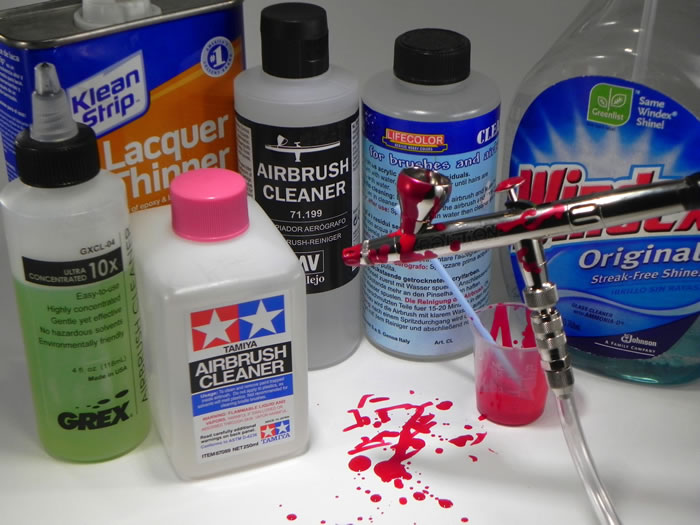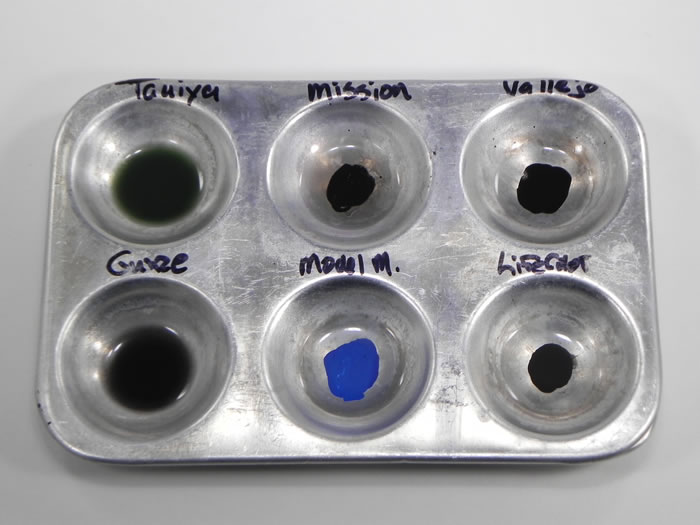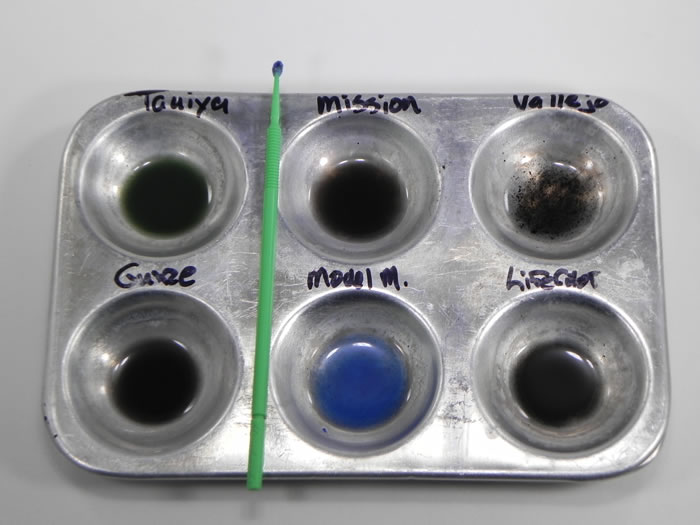Airbrush Cleaners and Suggestions on Getting the Gunk Out
by John Miller
|

|
Airbrush Cleaners |

Hobby Boss' 1/72 Macchi C.200 Saetta is available online from Squadron for only $10.99!
This little project tried to answer a simple question: How well do airbrush cleaner’s remove dried paint? Most people with a little airbrushing experience will tell you that wet paint is easier to remove from an airbrush than is dry paint. In fact, particles of dried paint clinging to the needle, nozzle and innards of our airbrushes cause multiple issues including loss of spray pattern, clogging, spitting, and even sneezing. Folks, it’s just not very pretty.
Many of us use commercially available airbrush cleaners to remove paint from our brushes following a normal painting session. And to be clear, most of the airbrush cleaners tested in this study will do an acceptable job removing paint that is wet or just partially dried. In contrast, the removal of paint that has dried completely to the metal surfaces of our airbrushes is the focus of this study.
Dried paint can be removed by a cleaning solution in two ways: 1) the cleaner can dislodge and/or fragment dried paint producing visible particles, or 2) the cleaner can dissolve or solubilize dried paint thereby putting it back into solution. From the standpoint of cleaning our airbrushes, a cleaner that dissolves or solubilizes dried paint is preferred. In order to test how efficiently common airbrush cleaners solubilize dried paint, the crew down in the secret underground paint research laboratory came up with something a little different.
The Airbrush Cleaner Test: |
To assess the ability of common airbrush cleaners to dissolve dried paint from multiple manufacturers, ~1 drop of each type of paint was used to coat the well of an aluminum paint palette. The acrylic paints used were dark colors from the Mission Models, Vallejo, LifeColor, Tamiya, and Model Master ranges. Gunze Mr. Color (a lacquer) was included for amusement.
After a 2-hour drying time, the painted wells were covered with ~0.5ml of a commercially available cleaning solution and allowed to sit for 20 minutes. After this time the palette was gently rocked to determine if any of the painted wells showed signs of paint solubilization(dissolving). Wells exhibiting complete solubilization are denoted with an “S+” in Table 1 below.
Wells that didn’t exhibit complete solubilization were aggressively scrubbed with a micro brush to determine if the paint was still adherent. Some paints would dissolve immediately with just a small amount of scrubbing and these are denoted with an “S-“ in Table 1 below.
In contrast to degrees of solubilization, some painted wells exhibited a fragmentation of the paint layer with little-to-no evidence of the paint actually dissolving. These wells are denoted by an “F” in Table 1. Wells that showed no effects to the cleaners being tested are denoted with an “I” in Table 1 for insoluble. The special category “G” for goo was used to describe the evil mess that cheap lacquer thinner turns some dried acrylics into: truly nasty.
If you’re wondering, whether I questioned my sanity for a moment: bent over, stirring little wells of dissolving paint with a microbrush--my camera at the ready. The answer is yes. Good thing the shop door was locked.
To give you an idea of what this little test looked like, photographs of the Life Color Airbrush Cleaner test palette are provided. The palette layout is as follows: 1) Upper row, from left to right-Tamiya, Mission Models, Vallejo, 2) Lower row, from left to right-Gunze, Model Master, Life Color. The first photograph (below) shows both the Tamiya and Gunze paint layers solubilized by Life Color cleaner.

The second photograph (below) shows that scrubbing of the same palette with a microbrush revealed that all but the Vallejo paint layer was dissolved. The Vallejo layer was fragmented.

Table 1:
Effects of Airbrush Cleaners on Dried Acrylic Paint Layers
Paint Manufacturer
| |
|
|
|
|
|
|
Cleaner |
Tam |
Mission |
Vallejo |
MM |
LC |
Gunze |
| |
|
|
|
|
|
|
Grex |
S+ |
S- |
F |
F |
S- |
I |
Vallejo |
S+ |
F |
F |
I |
S- |
I |
LifeColor |
S+ |
S- |
F |
S- |
S- |
S+ |
Tamiya |
S- |
S- |
S- |
S+ |
F |
S+ |
Windex |
S+ |
S+ |
I |
I |
I |
I |
Lacquer |
S+ |
G |
G |
S+ |
G |
F |
|
|
|
|
|
|
|
|
|
|
|
|
|
|
|
|
|
|
|
|
|
|
|
|
|
|
|
|
| |
|
|
|
|
|
Key: |
|
|
|
|
Abbreviations: |
|
|
|
|
|
|
|
| |
|
|
|
|
S+ |
Solubilized |
|
|
MM= Model Master |
S- |
Solubilized with brushing |
|
LC=LifeColor |
F |
Fragmented |
|
|
Tam=Tamiya Cleaner |
I |
Insoluble |
|
|
|
Win=Windex |
G |
Goo |
|
|
|
|
|
A quick glance at Table 1 shows that the Grex cleaner (#GXCL-04) is good for cleaning dried Tamiya, Mission Models, and LifeColor. Windex, a product that many modelers use when cleaning their brushes proved efficient at dissolving Tamiya and Mission Models but not much else.
A surprising result was the rather anemic performance turned in by Vallejo Airbrush Cleaner (#71.119). I was sufficiently surprised at the first round of results to purchase a new bottle of Vallejo Airbrush Cleaner for a repeat test: results were the same. Vallejo cleaner failed to solubilize but caused both Vallejo and LifeColor paints to fragment when brushed. A very small degree of solubilization was evident but nothing compared to the other cleaners. I suspect a longer soak time with the Vallejo cleaner would result in more solubilization than is evident in 20 minutes?
A pleasant surprise is LifeColor Airbrush Cleaner. This cleaner shows a pronounced ability to solubilize most of the acrylic paints tested plus Gunze Mr. Color, a lacquer. I’ll be replenishing my stock of LifeColor Airbrush Cleaner very soon.
Tied with LifeColor is the Tamiya Lacquer-based Airbrush Cleaner (#87089). I’ve been using this stuff for years as the final rinse step in my airbrush cleaning routine. No matter what type of paint I’m cleaning out of my brush (Vallejo, LifeColor, Gunze), the last solution I spray through it is Tamiya Airbrush Cleaner. I find that the lever actions of my brushes don’t bind even after many months in storage if they’re rinsed out with this cleaner before being put to bed: really good stuff. When you can find it, I suggest you stock up.
I’ve cleaned a lot of enamel and lacquer paints out of my airbrushes with lacquer thinner over the years so just for old times sake I included it in the test. The effect that cheap hardware store lacquer thinner (Klean-Strip) had on dried acrylics necessitated the category of “G” for goo. I would not want to remove this exceedingly sticky, tar-like material from my airbrush. A notable exception is Model Master acrylic, which is efficiently solubilized by lacquer thinner.
An additional take home point from the data is that you guys shooting Tamiya acrylics have no excuse for not having the cleanest airbrushes in the modeling kingdom. Every cleaner and thinner tested quickly solubilized dried Tamiya paint completely.
As mentioned earlier, wet paint is easier to clean than dried paint. If you can keep the paint in your airbrush innards wet until the moment you add thinner or cleaning solution to your brush, the clean up job will be much easier and more thorough with less work. An easy trick to remember is “Don’t Run It Dry.” No matter how hard fight the temptation to empty that last ¼ cup of paint at the trash can (or cat) until the hiss of air can be heard from your brush. That hissing is the sound of paint being air-dried to all the little nooks and crannies of your airbrush. By keeping the paint in your brush wet right up until you begin cleaning, the opportunity for the paint to dry is greatly reduced and the brush will be much easier to clean: simple.
Sooner or later however, you’ll forget your poor airbrush for an hour or two with the paint cup full of the nastiest acrylic paint known to mankind. In this situation you’ll probably be faced with cleaning dried paint out of your airbrush. Depending on the brand of the offending paint, you may be able to get away with just a long soak with the appropriate cleaner.
For example, if my brush were infested with dried Model Master Acrylic, I’d try a series of 15-minute soaks with either LifeColor or Tamiya cleaners. Lacquer thinner will work for Model Master but it’s the exception of all the acrylics tested. To remove dried Vallejo, I’d be reaching for my Tamiya cleaner and leave the other brands on the shelf. Conversely, dried Life Color is solubilized with a little scrubbing in Grex, Vallejo, or Life Color cleaners: many options. If you’re shooting the new Mission Models acrylics (my personal favorite) and have a dried paint problem, Grex, Vallejo, Life Color, Tamiya, and Windex are all good options.
Well, for those of you with a gooped-up airbrush hidden away in the bottom drawer of your workbench, I hope this serves to give you (and your airbrush) some hope. Likewise, for those who prefer a proactive approach to keeping their brushes clean, I hope you picked up a trick or two that makes that job a little easier.
Cheers,
John Miller
For more information on this article visit ModelPaintsolutions.com
Model and Text Copyright ©
2017 by Model Paint Solutions Inc.
Page Created 7 June, 2017
Last Updated
8 June, 2017
Back to
HyperScale Main Page

|
Home
| What's New |
Features |
Gallery |
Reviews |
Reference |
Forum |
Search